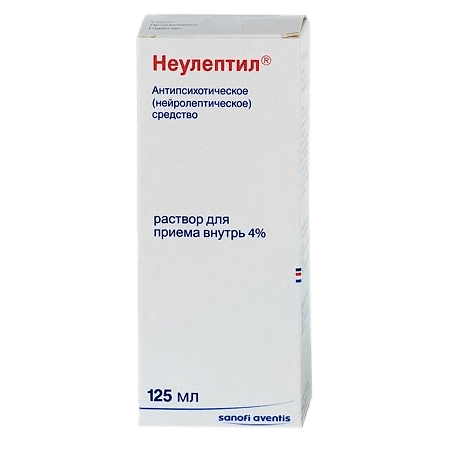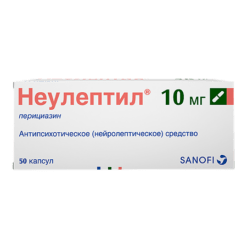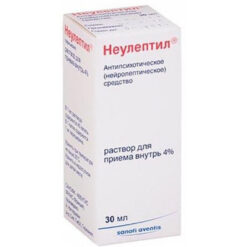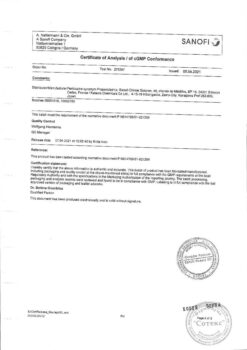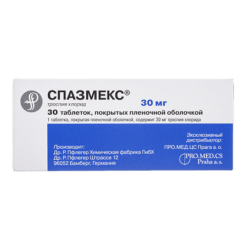No products in the cart.
Neulectil, 4% 125 ml
€49.18 €40.98
Description
Neuleptyl is a neuroleptic of phenothiazine piperidine derivatives. It has a moderate antipsychotic and sedative effect without a stimulant component. It has adrenolytic, antispasmodic, parasympatholytic, antiemetic, hypothermic effects. It potentiates the activity of narcotic and non-narcotic-hanalgesics and sleeping pills.
It has a clear sedative effect, reduces aggressiveness, excitability and disinhibition. It has a hypnotic effect.
Because of its selective normalizing effect on behavior, Neuleptyl has been called a “behavioral adjuster.”
Pharmacokinetics
It is well absorbed from the gastrointestinal tract. After oral administration, plasma concentrations are lower than those after intravenous administration (first-pass effect through the liver) and vary widely.
The binding to plasma proteins is 90%. Intensely penetrates into tissues, as it easily passes through histohematic barriers, including the blood-encephalic barrier. It penetrates into breast milk.
Metabolized in the liver by hydroxylation and conjugation, has a “first pass” effect through the liver, is subject to hepatic recirculation.
T1/2 – 30 h. Elimination of metabolic products is longer. It is excreted by the kidneys, with bile and feces.
Indications
Indications
psychopathy
psychopathic-like states in schizophrenia
disturbance of emotions in epilepsy.
Pharmacological effect
Pharmacological effect
Neuleptil is an antipsychotic made from piperidine phenothiazine derivatives. It has a moderate antipsychotic and sedative effect without a stimulating component. It has adrenolytic, antispasmodic, parasympatholytic, antiemetic, hypothermic effects. Potentiates the activity of narcotic and non-narcotic analgesics, hypnotics.
It has a distinct sedative effect, reduces aggressiveness, excitability, and disinhibition. Has a hypnotic effect.
Due to its selective normalizing effect on behavior, Neuleptil is called a “behavior corrector.”
Pharmacokinetics
Well absorbed from the gastrointestinal tract. After oral administration, plasma concentrations are lower than with intramuscular administration (the “first pass” effect through the liver) and vary widely.
Communication with plasma proteins – 90%. Penetrates intensively into tissues, as it easily passes through histohematic barriers, including the blood-brain barrier. Passes into breast milk.
Metabolized in the liver by hydroxylation and conjugation, has a “first pass” effect through the liver, and undergoes hepatic recirculation.
T1/2 – 30 hours. Elimination of metabolic products is longer. Excreted by the kidneys, with bile and feces.
Special instructions
Special instructions
In case of fever or infection, a complete blood count should be performed, as there have been reports of the possibility of developing agranulocytosis.
Active ingredient
Active ingredient
Periciazine
Composition
Composition
Active ingredient:
pericyazine;
Excipients:
sucrose,
ascorbic acid,
tartaric acid,
glycerol (glycerin),
peppermint leaf oil,
ethanol 96%,
caramel (E150d),
purified water.
Contraindications
Contraindications
Absolute:
angle-closure glaucoma;
urinary retention due to prostate diseases;
prostate adenoma;
Parkinson’s disease;
agranulocytosis, history of porphyria;
concomitant therapy with levodopa;
hypersensitivity to pericyazine.
The drug should be used with caution in patients with diseases of the cardiovascular system, renal and/or liver failure, and in elderly patients (excessive sedative and hypotensive effects may develop).
Side Effects
Side Effects
Neuleptil® is usually well tolerated, however, in some cases, the following adverse reactions may occur, the occurrence of which may or may not depend on the dose taken, and in the latter case, be a consequence of increased individual sensitivity of the patient.
From the central nervous system
Sedation or drowsiness, more pronounced at the beginning of treatment and usually disappearing after a few days.
Apathy, anxiety, mood changes.
In some cases, paradoxical effects are possible: insomnia, agitation, sleep inversion, increased aggressiveness and increased psychotic symptoms.
Extrapyramidal disorders (more often occurring when using the drug in high doses):
acute dystonia or dyskinesia (spasmodic torticollis, oculogyric crises, trismus, etc.), usually occurring within 4 days after starting treatment or increasing the dose;
parkinsonism, which often develops in elderly patients and/or after long-term treatment (weeks or months) and is partially eliminated by the appointment of anticholinergic antiparkinsonian drugs and is manifested by the appearance of one or more of the following symptoms: tremor (very often the only manifestation of parkinsonism), rigidity, akinesia in combination with or without muscle hypertonicity;
tardive dystonia or dyskinesia, usually (but not always) occurring with long-term treatment and/or use of the drug in high doses, and can occur even after cessation of treatment (if they occur, anticholinergic antiparkinsonian drugs have no effect and may cause deterioration);
akathisia, usually observed after high initial doses.
Respiratory depression (possible in patients with predisposing factors to the development of respiratory depression, for example in patients receiving other drugs that can depress breathing, in elderly patients, etc.).
From the autonomic nervous system
Anticholinergic effects (dry mouth, accommodation paresis, urinary retention, constipation, paralytic ileus).
From the cardiovascular system
Decreased blood pressure, usually postural hypotension (more common in elderly patients and patients with decreased circulating blood volume, especially at the beginning of treatment and when using high initial doses).
Arrhythmias, including atrial arrhythmias, atrioventricular block, and ventricular tachycardia, including potentially fatal torsade de pointes (TdP), are more likely when high doses are used.
ECG changes, usually minor: QT prolongation, ST segment depression, U wave and T wave changes.
Cases of thromboembolism, including pulmonary embolism (sometimes fatal) and cases of deep vein thrombosis, have been observed with the use of antipsychotics.
Endocrine and metabolic disorders (more often occurring when using the drug in high doses)
Hyperprolactinemia, which can lead to amenorrhea, galactorrhea, gynecomastia, impotence, frigidity.
Increase in body weight.
Thermoregulation disorders.
Hyperglycemia, decreased glucose tolerance.
Skin and allergic reactions
Allergic skin reactions, skin rash.
Bronchospasm, laryngeal edema, angioedema, hyperthermia and other allergic reactions.
Photosensitivity (more often when using the drug in high doses). Contact skin sensitization.
Hematological disorders
Leukopenia (observed in 30% of patients receiving high doses of antipsychotics).
Extremely rare: agranulocytosis, the development of which does not depend on the dose, and which can occur either immediately or after leukopenia lasting for two to three months.
Ophthalmological disorders
Brownish deposits in the anterior chamber of the eye, pigmentation of the cornea and lens due to the accumulation of the drug, usually not affecting vision (especially when using high doses of phenothiazine derivatives for a long time).
From the liver and biliary tract
Very rare: cholestatic jaundice and liver damage, predominantly cholestatic or mixed, requiring discontinuation of the drug.
Other
Neuroleptic malignant syndrome, a potentially fatal syndrome that can occur when taking all antipsychotics and is manifested by hyperthermia, muscle rigidity, autonomic disorders (pallor, tachycardia, unstable blood pressure, increased sweating, shortness of breath) and disturbances of consciousness up to coma. The occurrence of neuroleptic malignant syndrome requires immediate cessation of antipsychotic treatment. Although this effect of pericyazine and other antipsychotics is associated with idiosyncrasy, there are predisposing factors for its occurrence, such as dehydration or organic brain damage.
Positive serological test for the presence of antinuclear antibodies, without clinical manifestations of lupus erythematosis.
Very rare: priapism, nasal congestion.
Very rare: development of withdrawal syndrome upon abrupt cessation of treatment with high doses of pericyazine, manifested by nausea, vomiting, insomnia and the possibility of exacerbation of the underlying disease or the development of extrapyramidal disorders.
Among patients taking phenothiazine antipsychotics, isolated cases of sudden death, possibly caused by cardiac causes, as well as unexplained cases of sudden death have been reported.
Interaction
Interaction
Contraindicated combinations: with dopaminergic agonists (levodopa, amantadine, apomorphine, bromocriptine, cabergoline, entacapone, lisuride, pergolide, piribedil, pramipexole, quinagolide, ropinirole) in patients without Parkinson’s disease – mutual antagonism between dopaminergic agonists and pericyazine. Extrapyramidal disorders caused by taking a neuroleptic should not be treated with dopaminergic agonists (reduction or loss of neuroleptic activity) – in this case, the use of anticholinergic antiparkinsonian drugs is more indicated.
Not recommended combinations: with dopaminergic agonists (levodopa, amantadine, apomorphine, bromocriptine, cabergoline, entacapone, lisuride, pergolide, piribedil, pramipexole, quinagolide, ropinirole) in patients with Parkinson’s disease – mutual antagonism between dopaminergic agonists and pericyazine. Dopaminergic agonists may exacerbate psychotic disorders. If patients with Parkinson’s disease receiving dopaminergic agonists require treatment with an antipsychotic, they should be withdrawn by gradual dosage reduction (sudden withdrawal of dopaminergic agonists may increase the risk of developing neuroleptic malignant syndrome). When using pericyazine with levodopa, the minimum effective dose of both drugs should be used. With alcohol – potentiation of the sedative effect caused by pericyazine. With amphetamine, clonidine, guanethidine – the effect of these drugs is reduced when taken simultaneously with antipsychotics. With sultopride – an increased risk of developing ventricular arrhythmias, in particular ventricular fibrillation.
Combinations of drugs that require caution when used: with drugs that can increase the OT interval (class IA and III antiarrhythmics, moxifloxacin, erythromycin, methadone, mefloquine, sertindole, tricyclic antidepressants, lithium salts and cisalride and others) – increase the risk of arrhythmias. With thiazide diuretics, the risk of arrhythmias increases due to the possibility of developing electrolyte disorders (hylocalemia, hylomagnesemia). With antihypertensive drugs, especially alpha-blockers – an increase in hypotensive effect and the risk of developing orthostatic hypotension (additive effect). For clonidine and guanethidine, see the section “Interactions with other drugs”, subsection “Non-recommended drug combinations”. With other drugs that have a depressant effect on the central nervous system: morphine derivatives (analgesics, antitussives), barbiturates, benzodiazepines, non-benzodiazepine anxiolytics, hypnotics, neuroleptics, antidepressants with a sedative effect (amitriptyline, doxepin, mianserin, mirtazapine, trimipramine), blockers histamine H1 receptors with a sedative effect, centrally acting antihypertensives, baclofen, thalidomide, pizotifen – the risk of additional depressive effects on the central nervous system, respiratory depression. With tricyclic antidepressants, MAO inhibitors, maprotiline – an increased risk of developing neuroleptic malignant syndrome, and possibly increased and prolonged sedative and anticholinergic effects. With atropine and other anticholinergics, as well as drugs with anticholinergic effects (imipramine antidepressants, anticholinergic antiparkinsonian drugs, disopyramide) – the possibility of accumulation of undesirable effects associated with anticholinergic effects, such as urinary retention, constipation, dry mouth, heat stroke, etc., as well as reducing the antipsychotic effect of antipsychotics. With beta-blockers – the risk of developing hypotension, especially orthostatic (additive effect), and the risk of developing irreversible retinopathy, arrhythmias and tardive dyskinesia. With hepatotoxic drugs – increased risk of hepatotoxicity. With lithium salts – decreased absorption in the gastrointestinal tract, increased rate of excretion of lithium, increased severity of extrapyramidal disorders; Moreover, early signs of lithium intoxication (nausea and vomiting) can be masked by the antiemetic effect of phenothiazines. With alpha and beta adrenergic stimulants (epinephrine, ephedrine) – a decrease in their effects, a paradoxical decrease in blood pressure is possible. With antithyroid drugs – an increased risk of developing agranulocytosis. With apomorphine – a decrease in the emetic effect of apomorphine, an increase in its inhibitory effect on the central nervous system. With hypoglycemic drugs – when combined with antipsychotics, the hypoglycemic effect may decrease, which may require increasing their doses.
Combinations of drugs, the use of which has an interaction that should be taken into account: with antacids (salts, oxides and hydroxides of magnesium, aluminum and calcium) – decreased absorption of pericyazine in the gastrointestinal tract. If possible, the interval between taking antacids and periciazine should be at least two hours. With bromocriptine – an increase in plasma concentrations of prolactin when taking pericyazine interferes with the effects of bromocriptine. With appetite suppressants (except for fenfluramine) – reducing their effect.
Overdose
Overdose
Overdose can cause severe extrapyramidal disorders and coma.
Treatment should be symptomatic and carried out in a specialized department.
Storage conditions
Storage conditions
At a temperature not exceeding 25 °C
Shelf life
Shelf life
4 years
Manufacturer
Manufacturer
A.Nattermann & Hsieh. GmbH, Germany
Additional information
| Shelf life | 4 years |
|---|---|
| Conditions of storage | At a temperature not exceeding 25 °C |
| Manufacturer | A. Nuttermann & Sie. GmbH, Germany |
| Medication form | oral solution |
| Brand | A. Nuttermann & Sie. GmbH |
Other forms…
Related products
Buy Neulectil, 4% 125 ml with delivery to USA, UK, Europe and over 120 other countries.

